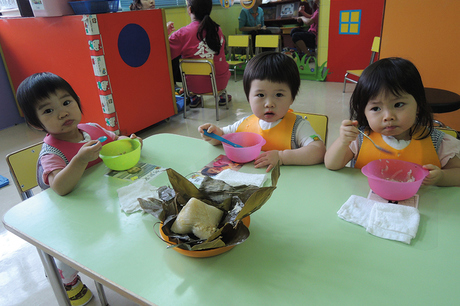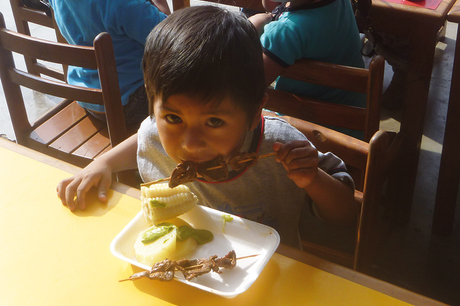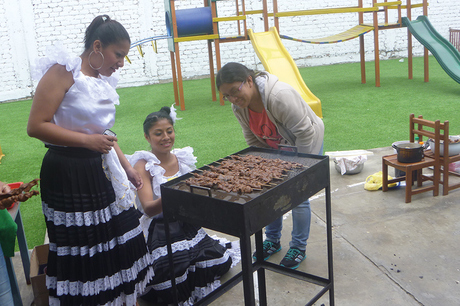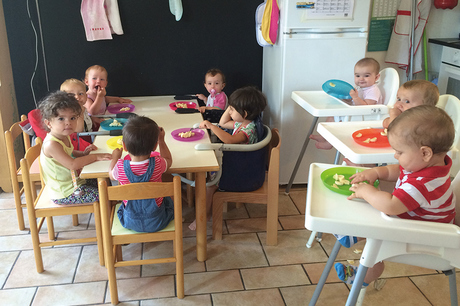
Whether it is quinoa jelly in Peru or fish porridge in Hong Kong, early years practitioners around the world put a lot of thinking into the food they offer their children. In the UK, settings are encouraged to plan weekly menus, taking in all the food groups – starchy foods, fruit and vegetables, non-dairy protein and dairy products – while oily fish should be offered at least once every three weeks (not more than twice a week as it can contain pollutants). But how does this thinking vary with climate and tradition? We look at three culinary cultures in Asia, Latin America and Europe.
HONG KONG

It is mid-September, and Hong Kong is lit up with lanterns, light shows and fiery dragon dances to celebrate the Mid-Autumn Festival. Children in the five crèches run by the Hong Kong Society for the Protection of Children are tucking into mooncakes. Round pastries with a sweet filling, these cakes are the traditional way to mark the harvest and the full moon.
‘We follow the Chinese culture, and sometimes use some Chinese herbs such as wolfberry and Chinese yam in our soups,’ says Mak Kang Ying, service director of the Hong Kong Society for the Protection of Children. The Dragon Boat Festival, commemorating the drowning of an ancient Chinese poet, is associated with eating dumplings made of sticky rice stuffed with different fillings and wrapped in leaves.
Across the society’s crèches, 320 children from birth to the age of two are fed according to menus designed by the centre supervisor, based on nutritional guidelines. Breakfast is served at 9.15-9.45am, fruit time from 11-11.15am, lunch from 11.45am-12.30pm, and afternoon tea from 3.45-4.15pm. ‘We think that regular mealtimes are important for children to develop a healthy daily routine,’ says Mr Mak.
On a Tuesday, for example, toddlers at its Air Cargo Community Day Crèche might be enjoying carrot and chicken millet porridge for breakfast, with a banana snack mid-morning. For lunch they may be given braised fish with green pea and bean curd, and soft brown rice, alongside a soup of tomato, cabbage and beef. Afternoon tea is banana bread pudding. Meanwhile, the older babies, who have been weaned, will be having milk for breakfast, apple puree for a snack, and pea, bean curd and fish porridge for lunch, with egg yolk and banana rice puree for afternoon tea.
The very youngest babies are given milk every three to four hours. ‘We encourage and support parents on breast-milk feeding, so many parents prepare the milk at home, which they will bring to the crèche every day,’ says Mr Mak.
When babies reach seven to 12 months, the settings introduce food allergy tests to identify any foods that need to be avoided. The children in this age group are given smooth puréed food thickened with cereal alongside their milk. ‘Eating a wide range of foods with different textures and tastes helps them to accept family foods more easily,’ says Mr Mak. As babies become toddlers, the settings introduce thicker pureed foods with small, soft, regular lumps of the same size and texture. ‘The ingredients mostly come from local markets; we will pay attention to their freshness and healthiness,’ says Mr Mak. ‘We make our own bread.’
Toddlers sit at tables in small groups, and are helped to use spoons – they start to learn to use forks when they reach 18 months. They are encouraged to use a small towel to wipe their mouth and to put away their utensils.
‘Older toddlers do have opportunities to prepare food themselves,’ says Mr Mak. ‘For instance, they need to peel the skin of bananas at fruit time, and they can experience the making of some foods, such as jelly or dumplings.’
Parents can attend talks on healthy cooking. ‘Some children when staying at home or outside the crèche become picky around foods and have a greater chance to eat junk food occasionally,’ says Mr Mak. ‘They might not have meals to such a regular schedule and they may eat less than in the crèche.’

Recipe: Mooncakes (makes ten mini cakes)
Combine 55g golden syrup with half a teaspoon of alkaline water (available from Chinese supermarkets) and 25g vegetable oil. Sift 105g plain flour into the mixture and mix gently. Cover the dough with clingfilm and leave to rest for 40 minutes. Divide 300g lotus seed paste – this can also be bought from Chinese supermarkets – into ten, and roll each one into a ball. Divide the dough into ten and roll each into a ball.
Preheat the oven to 150 degrees. Place the dough ball between two pieces of clingfilm and roll into a circle roughly 10cm across. Place the lotus ball in the middle of the pastry, bring the dough up to cover the filling and form a ball. Place the ball in a 50g mooncake mould (available from eBay) and press out onto a lined baking tray.
Bake for ten minutes. Remove, brush with egg yolk and bake for another ten minutes at 130 degrees.
PERU

The Westnell Nursery Society began when two UK volunteers, Sally Pinnel and Debra Westlake, visited the shanty towns of Lima in 1986. From 25 children receiving pre-school education in a shack, Westnell now has three purpose-built nurseries run by local women, offering essential education for birth to five-year-olds living in deprived areas.
Zoila Tarazona Arana is head of the Westnell nursery school in Callao, a port city some 15km from Lima. The 210 children who attend come for morning or afternoon sessions, and do not have lunch at the setting. However, they bring in mid-morning and mid-afternoon snacks from home in lunchboxes. ‘I insist that the food in these lunchboxes is prepared at home, which means the very important ingredient of love and affection can be transmitted through the food,’ says Ms Arana.
Children in the UK would recognise the fruit juice which the lunchboxes sometimes contain, but might be uncertain about another popular drink, a juice made from quinoa. Thick and slightly sweet, it is packed with protein and other nutrients. Everyday food might include bread with cheese, fried sweet potatoes, omelettes or quail’s eggs, and cut-up fruit such as apples, grapes and watermelon.
‘The way we serve the food helps teach children how to open boxes, chew properly and recognise good nutrition,’ says Ms Arana. ‘Before eating, the children clean their hands with alcohol gel, say Grace and lay the table with placemats and napkins. They help to bring out the food and serve themselves, teaching them good habits.’
Food is also a central part of bringing the community together in celebration. ‘When we celebrate Mother’s Day or Father’s Day, parents come into the nursery and help prepare the food,’ says Ms Arana. Today the menu consists of a vegetable salad, fried chicken and rice, and Aji de Gallina – a popular Peruvian dish comprised of chilli chicken in a creamy sauce, potatoes in a spicy cheese sauce and tamales, a starchy dough steamed in a corn husk and filled with meats, cheeses, vegetables or fruits. Another festival is El Dia del Campesino in June. ‘On that day we make a special “peasant” lunchbox with corn, cheese and corn nuts,’ says Ms Arana.
‘For national holidays, mothers prepare food typical of the three regions of Peru: the coast, the mountains and the jungle,’ she adds. Each region has its own food traditions, which the nursery tries to reflect. Coastal specialities include a layered potato dish, purple corn pudding and chicha morada, a drink made from purple corn. Fried pork with corn, and a jelly made from quinoa, are typical mountain dishes, while specialities of the jungle region include ripe bananas, a juice made from the cocona fruit and juane, a dish of rice, meat, olives, hard-boiled egg and spices, wrapped in macaw flower leaves. ‘For El Dia de la Cancion Criolla, celebrated in October, we prepare kebabs, which the children enjoy,’ says Ms Arana.

Recipe: Aji de Gallina (serves two)
Simmer two chicken breasts in a saucepan for eight to ten minutes, or until cooked through. Set aside on a plate to cool, reserving the stock.
Soak 50g white breadcrumbs in 200ml full-fat milk. Fry one large onion, chopped, in vegetable oil until softened. Add three cloves of chopped garlic and one large green chilli, with seeds removed, chopped, and fry for a further minute. Stir in one teaspoon of paprika and a quarter of a teaspoon of turmeric, salt and pepper, and fry for another minute.
Shred the cooked chicken and add to the pan, then add breadcrumbs and milk. Add 200ml of the reserved stock, bring to a boil, then lower the heat and simmer gently for five minutes. Stir in 35g ground walnuts and simmer for another five minutes, adding more stock if the sauce is too thick. Stir in 20g grated parmesan. Garnish with hard-boiled eggs and black olives.
ITALY

L’arca del Bebe, or ‘The Baby’s Ark’, nestles in the foothills of the Bergamo Alps in the town of Seriate, in the Italian region of Lombardy. The setting is what is known in Italy as a ‘micronido’ - attended by a small number of children – in this case there is room for up to ten between the ages of three months and three years.
Viviana Zanchi, who co-manages the nursery, says, ‘The latest government guidelines on healthy food for babies and young children are to cut down on salt, and specifically to provide bread with a low quantity of salt. The guidelines recommend a diet which gives the correct nutritional balance, with the correct proportion of carbohydrates and proteins, and fresh fruit and vegetables. Within the latest guidance it is also recommended to provide wholemeal or organic food where possible.’
Generally, children will have a light snack with fresh fruit at around nine in the morning, followed by the main meal at around 11.30am to noon. A first course of pasta, polenta, potato purée or gnocchi, is usually followed by meat, fish, cheese or eggs. This is always accompanied by a side dish of vegetables, often seasonal, offered either raw or steamed to retain their nutrients.
In the afternoons, at around half past three to four o’clock, children are given a snack based on dairy products, such as cheese, yoghurt or a milkshake with biscuits, or fruit.
‘The choice of food is definitely influenced by Italian culture, and the Mediterranean diet,’ says Ms Zanchi, ‘although in recent years we have opened to other cultures. Seasonal menus are used, usually a summer and winter menu, so choices are also based upon the local climate and temperature of the season.’ Nursery meals vary around the country because regional local authorities also have different guidelines which are commonly used by external catering services or in-house cooks.
The light, airy setting blends clean white walls and simple wooden furniture with colourful and enticing wall mats, climbing blocks and murals. Children eat around a child-sized wooden table, with babies in high chairs, in a kitchen with a fridge decorated with brightly coloured magnets and a green wooden dresser.
L’arca del Bebe has its own kitchen and qualified cooking staff, so children are able to help make some of the dishes, depending on their abilities.
The ingredients are sourced from trusted local grocery shops or suppliers. ‘In any case the ingredients should be always traceable in the supply chain,’ Ms Zanchi says.
Recipe: Gnocchi (serves four)
Boil 1kg potatoes until just tender. Drain, then gently remove peel, then mash. Stir in 200g plain flour, one lightly beaten egg and a pinch of salt. Knead to a soft, elastic dough and turn onto a lightly floured surface.
Shape the dough into long rolls just over 1.5cm in diameter, and cut into 2cm lengths. Press the balls lightly against the underside of a cheese grater to create a textured surface. Add the gnocchi, a few at a time, to a large pan of lightly salted boiling water, and remove with a slotted spoon as they rise to the surface. Drain, and serve with chosen sauce.









